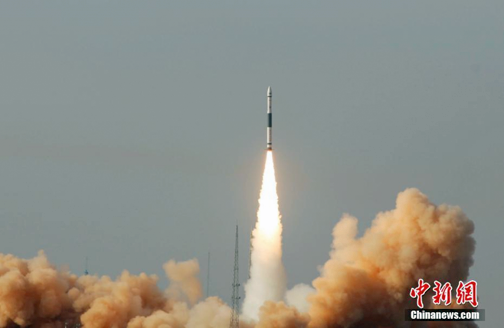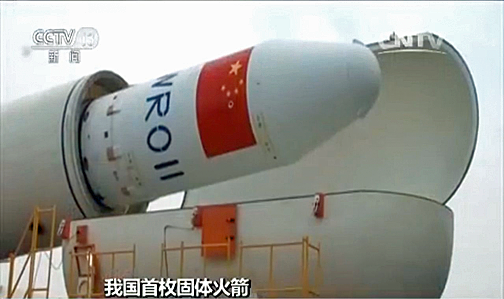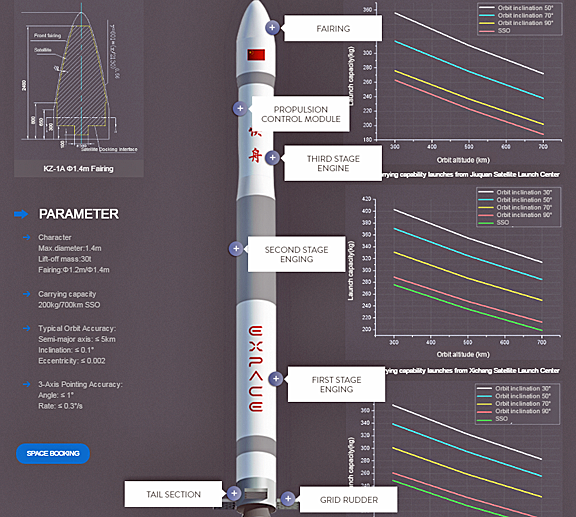Chinese commercial rocket launch company EXPACE has secured nearly US$182 million for the development and launch of its Kuaizhou series of solid fueled launch vehicles.

The first Kuaizhou-1A rocket lifts off from the Gobi Desert at 04:11pm UTC on January 9, 2017. Photo is courtesy of Chinanews.com.
CASIC Rocket Technology Company, also known as EXPACE and based in the city of Wuhan, said it signed fundraising agreements totaling 1.2 billion yuan with eight investment institutions at the Shanghai United Assets and Equity Exchange on Monday, this according to a Xinhua news service report. EXPACE was jointly established in February of 2016 by China Aerospace Science and Industry Corporation (CASIC), the state-owned defense giant and missile maker, and the China Sanjiang Space Group.
"The fund will be mainly invested in the development of Kuaizhou series carrier rockets, the rocket assembly facility and other upstream and downstream commercial space businesses," said Zhang Di, vice president of China Sanjiang Space Group and EXPACE chairman.
EXPACE is aiming to provide low-cost, rapid launch, light-lift services for commercial and foreign customers. EXPACE this year signed a contract which will involve launching four Kuaizhou-1A rockets within one week in 2018.

The Chinese Long March 11 rocket, covered by a casing, being prepared for the maiden flight of the KZ-01. Photo is courtesy of CCTV.
The CASIC Rocket Technology Company is based at the Wuhan National Space Industry Base in the capital of Hubei Province and was established in 2016 to facilitate the development of carrier rockets and satellites, commercial launch services and applications of satellite data. The Wuhan base itself is part of a national strategy for military and civilian integration.
The company's Kuaizhou-1A launch vehicle, capable of lifting 200 kg to a 700 km Sun-Synchronous Orbit (SSO) had its maiden flight in January of 2017, launching from a mobile launch platform at the Jiuquan Satellite Launch Center in the Gobi Desert. The maiden flight of the larger Kuaizhou-11, the company's latest carrier rocket which will be capable of lifting 1,000 kg to 700 km SSO, is expected to occur during the first half of 2018 and will carry a six satellite payload.
The first Kuaizhou-1A launch carried a Xingyun Shiyan-1 satellite, a technical verification test for CASIC's planned constellation of 156 mini LEO satellites aiming to provide narrow-band communications.
"The small LEO satellite constellations allow for Internet access and communications everywhere on the planet, including airplanes and ocean-going ships," Wang Yanan, chief editor of Aerospace Knowledge magazine, told state media in November.
The 156-satellite 'Xingyun' (cloud) constellation, orbiting at around 1,000 kilometres above the Earth, is slated to be completed by the end of 2025.

An infographic detailing the capabilities of the KZ-1A launch vehicle. Graphic is courtesy of EXPACE.
EXPACE is just one of a number of entities targeting solid propellant launch vehicles to provide 'low-cost' access to space for SmallSats. Private companies Landspace, Linkspace and OneSpace are all in various stages of development of their own rockets, while CASC, the main contractor for the government space program and a so-called sister company to CASIC, has developed the Long March 11 as a solid-propellant rocket addition to its Long March series.
CASC is aiming to test a sea launch service in 2018 using the Long March 11, taking advantage of lower fuel requirements to achieve orbit from lower latitudes.
Article source: gb Times.
For those interested in the broad range of technologies that drive and support the SmallSat various market segments, attendance at the upcoming SmallSat Symposium in Silicon Valley, California, should be of immediate consideration. So many subject-matter experts, so much to absorb... learn more at http://smallsatshow.com


